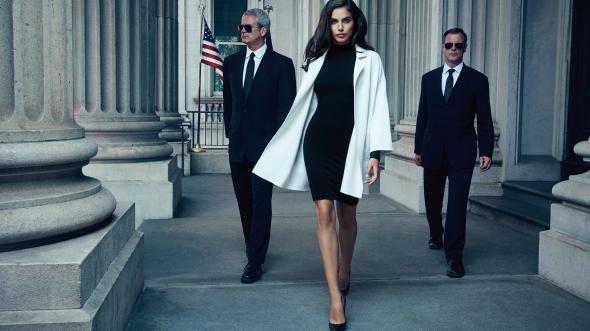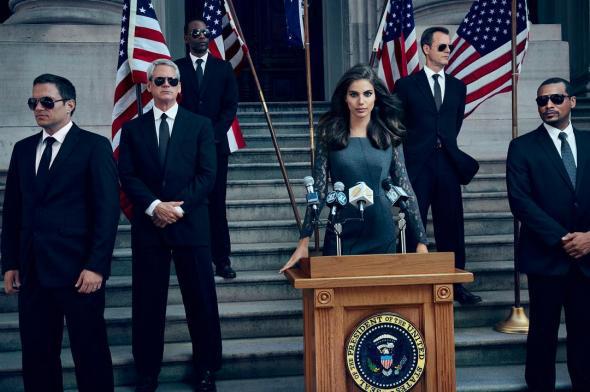The U.S. has never elected a female president before, so it’s hard to imagine what a woman’s presidency might look like. Will she wear an American flag barrette instead of a pin? Will she wear a pencil skirt and running shoes into the office, then change into a pair of heels she keeps under the Resolute desk? Will she enter the Situation Room carrying an enormous purse overflowing with Kleenex packets, stain sticks, and baggies of raisins?
No she will not, fashion designers predict, but she will just barely clear the office’s 35-year age requirement, and she’ll look an awful lot like Melania Trump.
That’s according to the visions of Elie Tahari and Donna Karan, who have both sold their clothing lines with ad campaigns depicting a female presidency. Karan’s 1992 “In Women We Trust” campaign featured model Rosemary McGrotha in a black-and-white series of soft-focus photos that made the presidency look like an exercise in refined ennui. In “Madam President,” Tahari’s recently launched campaign, model Shlomit Malka plays the role of a commander in chief who appears to have borrowed Beyoncé’s omnipresent hair fan for her tenure. Like McGrotha, Malka is surrounded by dull-looking men: secret Service agents in aviators, white-haired advisers shoving padfolios into her field of vision.
But while Donna Karan’s presidential wardrobe centered on feminized versions of menswear typically worn by U.S. presidents—pinstripes, double-breasted jackets, open button-down shirts—Tahari’s “Madam President” garb looks like a better fit for a sexy cocktail party than an early-morning briefing or Rose Garden address. Photographer James Macari captured Malka posturing in the Oval Office in a form-fitting red shift with see-through insets, preparing for a speech in lace sleeves, and striding Aaron Sorkin–style down a hallway in cigarette pants and a blazer with nothing but the most powerful cleavage in the world underneath.
Tahari’s ad campaign has more news relevance than Karan’s, which was meant as more of a symbolic fantasy in the early ‘90s. Though the current woman running for president bears little resemblance to his depiction of a 22-year-old model sashaying through the corridors of political power, Tahari means his campaign as an explicit endorsement of Hillary Clinton. “We have a choice between a man and a woman, and the woman is smarter and more humble, and I wanted to say I support that,” Tahari told the New York Times. Last month, he posted a Facebook photo of himself shaking Clinton’s hand in what looks like the Oval Office during Bill Clinton’s presidency. “Looking forward to seeing you here soon, Hillary Clinton,” read the caption.

James Macari/Elie Tahari
The Times reports that Clinton wore some of Tahari’s clothes as secretary of state; he and his wife fundraised for Clinton during the 2008 presidential primary. “What could be more powerful than a woman in the Oval Office?” Tahari said to Women’s Wear Daily in July. “This is an exciting and historic moment. A woman is finally going to be President of the United States.”
Along with print ads in fall issues of fashion magazines and digital ads in the Times, Vogue, and Harper’s Bazaar, Tahari has launched a Snapchat filter that lets users put themselves behind a bouquet of microphones on a lectern marked with the presidential seal. However ridiculous the average Snapchatter looks pretending to be the leader of the free world, she may end up looking more presidential than the sultry young brunettes of Karan and Tahari’s worlds. Research suggests—and anecdotal evidence confirms—that the first female president will most likely be blond.
